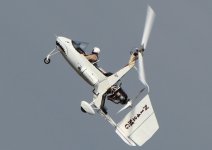I've been building, flying and selling 145-165HP normally-aspirated, factory stock, carb & FI gyro engines that weigh 20 - 28 lbs less than the Edge turbo 912 since 2012. What's all the fuss? 10,000+ fleet hours, not a single engine-out in all of our 9 years.
My personal gyro is a 570 lb (DW) carbbed 145 HP Air Command Yamaha that I first flew November 2012, 9 years ago.
Relax.
Nuttin' to worry about, just be careful on those super-steep climbs, they require lots of rudder authority; work up to them like a race car driver works up to going 200 mph on the track, and throttle back when rolling out at the top of a climb.
Take-off and powering out of downwind turns is a dream. Once the nose comes up go full throttle and literally launch. None of this pushing the nose over and gaining AS nonsense before going climb, although when you're getting used to it it's better to continue going with that method for a while.
This Air Command tandem has a TOW of 795 lbs. with 1 hour of fuel and 200 lbs pilot w/ gear.
2021 Mohawk Aero YG4 Grass Field Take Off

